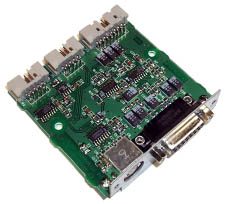 |
by Jag |
|
| | Tired of waiting for USB-MIDI vaporware drivers or USB-to-MIDI serial adapters? Check out Griffin Technologies iPort, an amazingly effective and inexpensive way to add a serial port and bonus video mirroring to your original Rev/A or /B ("Bondi") iMac! After receiving my iMac a few months ago, I was immediately reminded of the 'limitations' of this exquisite machine. I say limitations in quotes because they really aren't limitations, they are what I call 'growing pains'. Let me explain. As Apple moves to regain the forefront of PC technology (and they are doing so quite handily I might add) they chose to migrate to the USB standard, leaving behind the traditional ADB and serial ports of the past 11 years. This was a good decision as we all now understand, so I won't go into the why's and wherefores of this decision here. Now that the break with the past has been made, the 'growing pains' begin. Out of all the criticism the early iMacs endured, one of the more legitimate complaints that was voiced was the fact that there was no way to connect old serial peripherals to the iMac without adapters. Fledgling composers particularly have found this an issue. Finally, Apple creates a powerful, affordable Mac to replace your aging IIci or Quadra and there's no easy way to use your old serial MIDI peripherals! Sure, most of the major music software or hardware manufacturers have announced USB adapters, but after nearly a year we're still waiting for reliable USB-to-MIDI drivers! Enter the Griffin Technology iPort: it's a card that fits into the iMacs 'Mezzanine' slot. (only available on the Rev/A and Rev/B ("Bondi") iMacs, not the fruit colored iMacs). The iPort brings a traditional serial (printer/modem) port to the iMac and as a bonus adds video-mirroring capability as well. What is video mirroring? It allows you to attach another monitor that mirrors the iMac's monitor. In other words, two monitors with the exact same screen. Unfortunately, creating one large desktop with multiple monitors is not possible with the iPort. Installation To install the iPort, the iMac has to be literally disassembled. Don't worry, it's not as bad as it sounds. Griffin supplies a well-written installation manual with lots of pictures. All it really means is that you must unscrew a few screws and pull the bottom part of the case out from the top part and slide the iMac motherboard out. Next, the Mezzanine slot must be partially disassembled so that the iPort may be installed into the port. (The iPort doesn't actually use the Mezzanine slot, it merely attaches to the motherboard where a Mezzanine card would go. According to Griffin, a carefully installed iPort will not void your iMac's warranty.) There are several cables which must be carefully arranged to fit into their proper place as the iPort is popped into place. Be careful not to pinch any of the ribbon cables during reassembly. At this point, you really see how intricate and delicate the iMac really is. By the way, the guys at Griffin must be a mad bunch, as they pepper the installation guide with jokes that at one point say "the motherboard may be thrown away as it is no longer needed"! Don't worry, in case you're tempted to follow the instructions a little too closely, they followed the joke with a disclaimer in italics. I had some trouble getting the iMac case halves to meet in exactly the right place, so 'snapping' the interlocking parts back together took me almost as long as it took me to install the iPort. Total elapsed time: 45 minutes. (I moved very slowly and delicately when I got the motherboard. You should too. I recommend using a grounding strap!) A word of advice: if you have a cat, make sure it's outside during the install process - mine loves to poke her nose into everything I do, and I just wasn't in the mood for my iMac to get zapped by a fuzzy, electrified creature. Putting the iPort to the Test The MIDI converter worked flawlessly, but my ancient Yamaha DX 100 had to be seriously dusted as the sliders had become quite noisy after many years of neglect. (Hint: if you have a cat, don't let it sleep on your keyboard unless it's in a case. NO, the keyboard, silly.) I then attached an older Apple monitor to the video port and was pleased to see perfect video mirroring. This is useful for using a larger monitor with your iMac or for outputting video for presentations. Comments
Jag is an avowed 'old Mac lover', musician and computer tinkerer. You can read more about this fascinating guy at Jag's House, THE web resource on older Macs. Email Jag
|
| |
